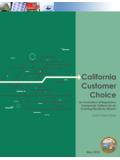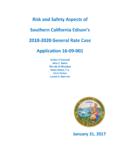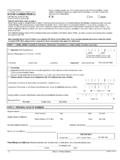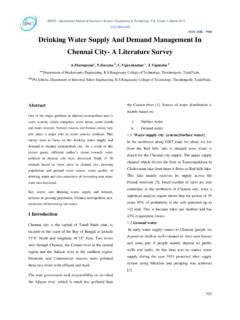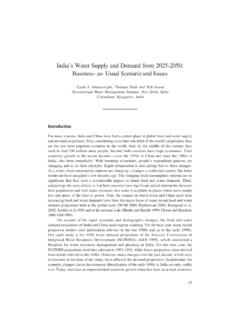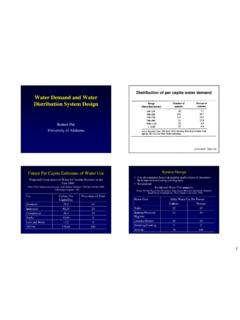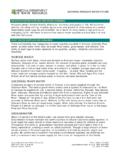Transcription of CHAPTER 2 Water Demand, Supplies, and Water Rights
1 CalAm Monterey Peninsula Water supply Project 2-1 April 2015 Draft EIR CHAPTER 2 Water demand , supplies , and Water Rights Sections Tables Introduction Background CalAm Service Area demand Available supplies Plant Capacity Other supply and demand Considerations Water Rights 2-1 Seaside Groundwater Basin Adjudicated Operating and Natural Safe Yields with CalAm s Pre-Adjudication Production 2-2 Existing demand 2007-2011
2 2-3 Other demand Assumptions 2-4 CalAm Monterey District Water supplies with Proposed MPWSP 2-5 Average Daily supply and demand Assuming MGD Desalination Plant, by Month 2-6 Maximum Month demand 2-7 Existing Service Area demand 2007-2013 2-8 Future Water demand Service Area Jurisdictions 2-9 Base and Future Water Use Assumed in 1981 Allocation 2-10 Allocation of Paralta Well supply in CalAm Service Area Introduction This CHAPTER describes the Water demand and supply assumptions for the Monterey Peninsula Water supply Project (MPWSP or proposed project).
3 In April 2012, California American Water (CalAm) filed Application with the California Public Utilities Commission (CPUC) requesting a Certificate of Public Convenience and Necessity1 and approval to construct, own, and operate the proposed project. CalAm s application included, among other things, Water demand and supply assumptions for the proposed project. In January 2013, CalAm submitted supplemental testimony that updated and superseded the Water demand and supply estimates provided in the April 2012 application. The demand and supply assumptions presented below are based on the information provided in January 2013.
4 The proposed project would develop supplemental supplies to serve CalAm s Monterey District service area (Monterey District). The Monterey District encompasses most of the Monterey Peninsula, including the cities of Carmel-by-the-Sea, Del Rey Oaks, Monterey, Pacific Grove, Sand City, and Seaside, and the unincorporated areas of Carmel Highlands, Carmel Valley, Pebble Beach, and the Del Monte Forest. CalAm s main distribution system is located within these areas. The main distribution system relies on Water supplies from the Carmel River2 and groundwater from the Coastal subarea of the Seaside Groundwater Basin.
5 CalAm s Monterey 1 Public Utilities Code Section 1001 et seq. require that investor-owned utilities seeking to construct certain specified infrastructure obtain a Certificate of Public Convenience and Necessity from the CPUC demonstrating that the proposed infrastructure is necessary for the service, accommodation, convenience, or safety of the public. 2 The Carmel River supply is composed of surface Water from the Carmel River and Water flowing through the alluvial aquifer that underlies and closely parallels the surface Water course of the river, which State Water Resources Control Board Order 95-10 concluded was the river s underflow.
6 2. Water demand , supplies , and Water Rights CalAm Monterey Peninsula Water supply Project 2-2 April 2015 Draft EIR District also includes five small independent Water systems along the Highway 68 corridor east of the City of Monterey (Ryan Ranch, Bishop, Hidden Hills, Toro, and Ambler). As described below in Section , the Toro and Ambler areas would not be served by the proposed project; therefore, these areas are not included in the demand assumptions. CalAm is proposing this project to replace part of its existing Water supplies , which have been constrained by legal decisions affecting CalAm s diversions from the Carmel River and pumping from the Seaside Groundwater Basin.
7 State Water Resources Control Board (SWRCB) Order 95-10, SWRCB Order 2009-0060 ( Cease and Desist Order, or CDO), and the Monterey County Superior Court s adjudication of the Seaside Groundwater Basin in 2006 substantially reduced CalAm s Rights to use these two primary sources of supply for the Monterey District. Section provides information about these decisions. Section discusses the components of demand that would be met by the proposed project, and Section describes the Water supply sources that would be used to meet those demands. Section discusses considerations relating to the plant sizing and Section describes other factors that could affect future Water supplies and demand in the Monterey District.
8 Background Historical Sources of supply San Clemente Dam was constructed on the upper Carmel River in 1921 to form San Clemente Reservoir. Surface Water diverted at San Clemente Dam was the sole Water supply for the Monterey Peninsula until the 1940s. Starting in the 1940s and continuing into the early 1990s, multiple production wells were installed in the Carmel Valley aquifer along the lower reach of the Carmel River. In 1951, Los Padres Dam, which forms Los Padres Reservoir, was constructed about 6 miles upstream of San Clemente Dam to control the inflow of Water into San Clemente Reservoir.
9 CalAm has owned and operated both reservoirs since 1966. Over the years, sediment accumulated behind San Clemente and Los Padres Dams significantly reduced the usable storage in both reservoirs. As a result, by 1995 CalAm relied primarily on the multiple wells in the alluvial aquifer along the lower Carmel River for its Carmel River supplies and more recently CalAm has relied entirely on these wells for its Carmel River In addition to Carmel River supplies , CalAm operates several production wells in the Coastal subarea of the Seaside Groundwater Basin. The Seaside Groundwater Basin, which encompasses 24 square miles, is generally bounded by the Pacific Ocean to the west, the Salinas Valley to the north, the Toro Park area to the east, and Highways 68 and 218 to the south.
10 The Seaside Groundwater Basin consists of several distinct subareas formed by geologic features that act as partial hydrogeologic barriers between the subareas. East of the main distribution system and along the Highway 68 corridor, CalAm operates wells in the Laguna Seca subarea of the Seaside Groundwater Basin (CalAm, 2006) that supply the Ryan 3 In June 2013 CalAm commenced removal of the San Clemente Dam; the removal project is expected to take three years. 2. Water demand , supplies , and Water Rights CalAm Monterey Peninsula Water supply Project 2-3 April 2015 Draft EIR Ranch, Bishop, and Hidden Hills satellite systems.
